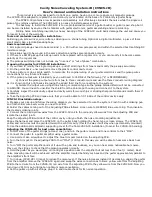
U2829 Series Operation Manual Chapter 7 Command Reference
110
0 (decimal 48) is equal to OFF.
For example: WrtCmd (“TRAN:Lx:STAT:ON”) Set all Lx parameters to be valid.
Query syntax: TRAN:Lx:STAT?
Return format: <NR1><NL^END>
The TRAN:Lx:FREQ command is used to set the Lx test frequency. The
TRAN:Lx;FREQ query returns the current Lx test frequency.
Command syntax: TRAN:Lx:FREQ <value>
Where,
<value> is NR1, NR2 or NR3 data format followed by HZ, KHZ and MHZ.
For example: WrtCmd (“TRAN:Lx:FREQ 1KHZ”) Set the Lx test frequency as
1KHZ.
Query syntax: TRAN:Lx:FREQ?
Return format: <NR3><NL^END>
The TRAN:Lx:LEVel command is used to set the Lx test level. The TRAN:Lx:LEVel
query returns the current Lx test level.
Command syntax: TRAN:Lx:LEVel<value>
Where,
<value> can be NR1, NR2 or NR3 data format followed by mV or V.
NOTE: <value> ranges from 5mV to 2V. Beyond this range, error information will
be reported.
For example: WrtCmd (“TRAN:Lx:LEVel 1V”)
Query syntax: TRAN:Lx:LEVel?
Return format: <NR3><NL^END>
The TRAN:Lx:LIMit command is used to set the Lx nominal value, high and low
limits. The TRAN:Lx:LIMit query returns the current nominal value, high and low
limits.
Command syntax: TRAN:Lx:LIMIit <value>, <low limit>, <high limit>
Where,
<value> is the Lx nominal value in NR1, NR2 or NR3 data format followed by H.
<low limit> is the Lx low limit in NR1, NR2 or NR3 data format.
<high limit> is the Lx high limit in NR1, NR2 or NR3 data format.
NOTE: The low limit should be smaller than the high limit, or error
information will be reported.
For example: WrtCmd (“TRAN:Lx:LIMit 0.01H, -0.01, 0.01”)
Query syntax: TRAN:Lx:LIMit?
Return format: <NR3>,<NR3><NR3><NL^END>








































